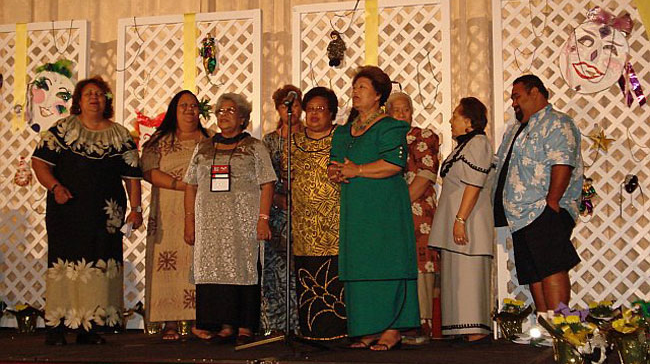
Talofa! Samoans are those with ancestry to the indigenous people of American or Western Samoa, which are islands located in the south Pacific about half way between Hawaii and New Zealand. According to the 2000 census, there were 91,029 Samoans living in the United States and 49,804 Samoans in California, and over 60% (31,076) living in Southern California. A considerable percentage (20%) falls under the federal poverty line compared with 8% of whites. Twenty-two percent of Samoans possess less than a high school degree, and only 10% have earned a college degree (APALC, 2005). Seventeen per cent have limited English proficiency, and 6% are linguistically isolated (with no one over the age of 14 in their household speaking proficient English).
Obesity is of considerable concern for Samoans; one study of four islands with differing degrees of Westernization found overweight prevalence ranging from 33% to 75% in males, and 46% to 80% in females (McGarvey, 1991). Rates of prostate cancer among native Hawaiians and Samoans rose from 140 to 175 per 100,000 during the 1990s then remained steady through 2006. Rates of uterine cancer among native Hawaiians and Samoans spiked from 30 to 90 per 100,000 in the 1990s then dropped to 60 in 2001-2006 (L. A. Cancer Surveillance Program, 2009). Breast cancer is the leading site for cancer among Samoan women in California, comprising 26.8% of cancer cases, (Mishra et al., 1996) and Samoans experience significant barriers to both early detection and follow-up. Breast cancer screening rates among Samoan women living in Los Angeles are below the Healthy People 2010 guidelines (Healthy People 2010). For instance, studies of Samoan women in Hawaii and California found that only 33% had ever received a mammogram and 63% a Pap smear (Mishra et al., 1998; Mishra et al., 2001). In a study by Mishra et al. (2001) cultural beliefs among Samoans living in Los Angeles, Honolulu and American Samoa, revealed that cancer and prevention (including cancer prevention) were absent from the Samoan culture. An earlier survey study of Samoans living in Los Angeles, Hawaii, and American Samoa revealed that cancer might be a divine punishment, and that a traditional healer can cure cancer (Mishra, et al., 2000).
In September of 2013, the Cancer Prevention Institute of California published cancer incidence trends among Samoans between the years of 1990 and 2008.
The five most commonly diagnosed cancers among Samoan males were prostate, lung, colon/rectum, liver and stomach. Annual rates of lung and liver cancer decreased by 1.3 and 1.0, respectively. Notable trends include prostate cancer increasing steadily by 0.9 percent annually and a significant improvement observed in stomach cancer diagnoses with a 9.8 percent decrease. Meanwhile, colon/rectum rates remained stable over the 19-year period.
The five most commonly diagnosed cancers among Samoan females were breast, uterine corpus, lung, colon/rectum, and stomach. Observed trends include an increase in breast, uterine corpus, and colon/rectum cancer rates by 2.7, 7.3, and 5.7 percent, respectively. In contrast, lung cancer rates decreased by 1.5 percent each year and stomach cancer rates by 6.7 percent.
Cancer Incidence Rate Percent Change |
||
|---|---|---|
Samoan |
Male |
Female |
Prostate |
+0.9% |
|
Lung |
-1.3% |
-1.5% |
Colon/rectum |
No change |
+5.7% |
Liver |
-1.0% |
|
Stomach |
-9.8% |
-6.7% |
Breast |
+2.7% |
|
Samoan National Nurses Association (SNNA) is a 501(c) (3) nonprofit organization founded in 1996 by a committed group of professionals serving the Samoan community across the country to improve and expand the community’s opportunities through service, education, advocacy, organizing, and research. SNNA has an annual budget of approximately $200,000, and employs 11 nurses who conduct outreach and education on a variety of topics, including tobacco control, the PI Women’s Breast Health and Breast Cancer Early Detection Program, the PATH for Women Project (for breast and cervical health), Breast Cancer Awareness-the Fa’a Samoa Way Project, and CARE for APIs (Care and Resource Management for API Older Adults), and the Health Access for Pacific Asian Seniors Project (HAPAS). Through their cancer control efforts SNNA has implemented a monthly survivor support group, conducted yearly mobile unit screenings, and developed the first-ever materials promoting cancer screening and cancer survivorship among Samoan women. Their newsletter “Sulu O Le Tautua” promotes their many activities to the Samoan communities across the U.S.
Contact: Dorothy Schmidt-Vaivao, Executive Director
Samoan National Nurses Association
1950 E. 220th St., #301
Long Beach, CA 90810
Tel: (310) 952-1115
Fax: (310) 952-0737
Email: dorothyvaivao@yahoo.com
Union of Pan Asian Communities (UPAC) was founded in 1974 with the mission to meet the social, psychological, physical, and economic needs of San Diego’s Asian and PI populations. The UPAC staff represents over thirty-one different cultures, languages, and dialects, and serves over 34,000 people annually. Services include prevention education and treatment in the areas of health (including tobacco and breast cancer), mental health (including counseling and treatment), domestic violence, substance use and abuse, as well as economic development. UPAC has been active in tobacco prevention education for the Asian and PI communities for the last ten years, and has participated as an advisory council member of the statewide Asian & Pacific Islander Tobacco Education Network as well as Asian & Pacific Islander Communities Against Tobacco.
Contact: Coming Soon!
Download Adobe Acrobat Reader Adobe Reader | Download Word viewer, or download Excel viewer, or download PowerPoint viewer Microsoft Viewers